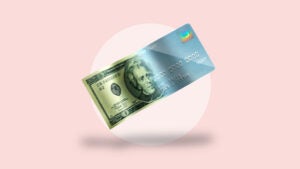Debt dominates the 2023 credit cards year in review

For a second straight year, the biggest theme in the credit card industry in 2023 was debt. Specifically, more people are carrying more of it for longer periods of time — and at record-high interest rates. Paying down debt is Americans’ top financial resolution for 2024, according to a recent Bankrate survey.
Our most recent credit card debt survey conducted over the summer revealed that 47 percent of credit cardholders carry balances from month to month, up from 39 percent in 2021. And 60 percent of these individuals with credit card debt have been in debt for at least a year, up from 50 percent in 2021.
Americans’ total credit card balances add up to a record $1.08 trillion, according to the New York Fed. That’s a whopping 40 percent increase since the first quarter of 2021.
Remember when credit card balances fell 17 percent from the fourth quarter of 2019 to the first quarter of 2021? That’s a distant memory at this point. The drop was artificial, of course, as many Americans used their COVID stimulus funds to pay down debt in 2020, plus a lot of people spent less due to the pandemic.
Even considering the “normalization” that was bound to occur after such an unusual period, the past couple years have been off the charts. The past two years, Americans’ credit card balances have skyrocketed 15 percent and 17 percent, respectively (from Q3 2021 to Q3 2022 and from Q3 2022 to Q3 2023). In the years immediately prior to the pandemic, credit card balances typically grew between four and five percent annually.
Inflation is a big part of the story, of course
Inflation peaked at 9.1 percent in June 2022, as measured by the Consumer Price Index — the highest inflation rate on record since November 1981. In an effort to bring inflation down, the Federal Reserve has raised interest rates by five-and-a-quarter percentage points since March 2022. The medicine has been working, as the latest CPI report clocked in at 3.1 percent annual inflation. But still, all of this has taken a significant toll on consumers.
Inflation has raised the cost of just about everything we buy, and if you have credit card debt, it’s a double whammy because you’re paying a higher interest rate on top of those higher prices. And by the way, inflation coming down doesn’t mean prices are rolling back to pre-pandemic levels. It just means prices are rising more slowly. They’re still going up, for the most part, and there’s a cumulative effect associated with building off a higher base.
Higher interest rates are another headwind
The average credit card rate rose more in 2022 (3.30 percentage points) than any year since we started tracking in 1985. It has “only” gone up 1.12 percentage points this year, but still, it’s a record-high 20.72 percent. And I’ll again note that cumulative effect.
The national average has jumped 4.42 percentage points in two years (more than any other two-year span on record). And most cardholders are actually paying 5.25 percentage points more than they were two years ago, since Fed rate hikes are directly passed through to most cardholders. The national average hasn’t moved that much due to various technical factors — for example, the average reflects new offers (some of which come on and off the market) as well as the limit that federally-chartered credit unions can’t charge more than 18 percent by law.
The debt dilemma
People generally get into credit card debt for practical reasons, namely emergency expenses (such as unexpected medical bills, home repairs and car repairs) and day-to-day expenses outpacing their paychecks. Those were the top two answers in our aforementioned credit card debt survey.
But practical explanations don’t make it any easier to get out of debt. If you only make minimum payments toward a $6,088 credit card balance (the national average, according to TransUnion) at the average interest rate of 20.72 percent, you’ll be in debt for 214 months and will owe $9,063 in interest. At the beginning of 2022, the average credit card rate was 16.30 percent. Rate increases have added 10 months and $2,068 in interest to the minimum payment scenario (assuming the same $6,088 balance).
My top tip for paying down credit card debt is to sign up for a balance transfer credit card with a lengthy 0 percent interest promotion. A silver lining is that these cards have remained widely accessible, even in a rising-rate environment.
You can transfer your existing high-cost debt over to a card such as the Citi SimplicityⓇ Card, which has a 21-month 0% intro balance transfer offer for new customers who transfer their balances within four months of opening the account. The regular variable APR ranges from 19.24 percent to 29.99 percent, depending on the cardholder’s creditworthiness, and the intro balance transfer fee is 3% of each transfer (minimum $5) completed within the first 4 months of account opening. After that, your fee will be 5% of each transfer (minimum $5).
Avoiding interest for nearly two years could save you hundreds or maybe even thousands of dollars, provided that you’re disciplined about paying off your balance.
It’s still a risk-on environment for lenders
A major explanation for why 0 percent balance transfer cards remain so widely available is because the household debt-to-income ratio is relatively low, historically speaking. A strong job market is helping people keep up with their bills.
And despite myriad economic worries, credit is still flowing freely. Americans opened a record 82.1 million credit card accounts in 2022, according to Equifax. In the first eight months of 2023 (the most recent data the credit bureau has released), card openings were down just 3 percent from last year’s record level.
Numbers can be funny sometimes, since one could focus on the fact that credit card delinquencies have approximately doubled over the past two years, and that sounds very alarming. But delinquencies, like credit card balances, were artificially low during the pandemic because of all that stimulus money and also because people spent less for a while. Many qualified for hardship programs, too.
Despite the recent rise in delinquencies, I don’t get the sense that banks are particularly alarmed at the moment. “Normalization” has been the party line during earnings calls and in other public comments. And perhaps the best proof that banks are not overly concerned is that credit card issuers doled out credit limits of $296 billion on those newly-issued cards (year-to-date through August). That’s 8.7 percent ahead of last year’s record pace.
Consumers are still opening new cards in droves
In 2023, there has been a slight drop in credit card originations but a sizable increase in new credit lines relative to last year. This means new cardholders are being approved for larger limits, likely because these new cardholders skew higher in terms of credit scores and/or incomes.
That hypothesis is backed up by Equifax’s data, which shows that a mere 17.9 percent of new credit cards went to people with subprime credit scores, the lowest share since 2014. It has gotten harder to obtain credit if you have a lower credit score, but those with good credit to excellent credit probably haven’t noticed much of a difference.
Consumers have been signing up for credit cards in droves the past couple years, so issuers haven’t needed to knock themselves out by offering extravagant welcome bonuses. Like last year, I would describe the state of sign-up bonuses as good but not great. Some people are signing up for cards because they need credit — they’re looking to finance purchases over time. Others are doing so primarily for rewards and convenience. The latter is obviously more desirable, as paying in full and avoiding interest is when credit cards can really work for you.
The bottom line
In many respects, 2023 has been a “Goldilocks” year for credit card issuers (not too hot or too cold). Consumer spending has been remarkably robust, especially on experiences such as travel, dining and live entertainment. Higher interest rates are padding banks’ net interest margins and the strong job market is keeping delinquencies and defaults in check.
From a consumer perspective, 2023 has represented the proverbial tale of two cities. Economic inequality continues to grow, and there’s a tremendous gap between the roughly half of cardholders who pay in full each month and earn valuable benefits from their cards versus the other half (more or less) who can quickly become mired in an expensive debt cycle.
If you have credit card debt — don’t be ashamed, you have plenty of company — it’s so important to come up with a plan to pay it off as soon as possible. Balance transfer cards, nonprofit credit counseling, side hustles and cutting your expenses are all valuable strategies that can free up more money to pay down what is probably your highest-cost debt by a wide margin.
Have a question about credit cards? Email me at ted.rossman@bankrate.com and I’d be happy to help.
Why we ask for feedback Your feedback helps us improve our content and services. It takes less than a minute to complete.
Your responses are anonymous and will only be used for improving our website.






